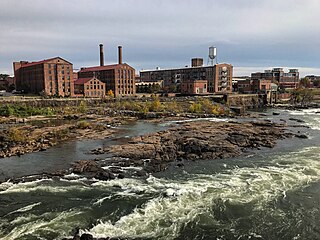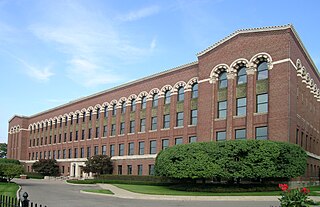
Muscogee County is a county located on the central western border of the U.S. state of Georgia; its western border with the state of Alabama is formed by the Chattahoochee River. As of the 2010 census, the population was 189,885. Its county seat and only city is Columbus, with which it has been a consolidated city-county since the beginning of 1971.

Columbus is a consolidated city-county located on the west-central border of the U.S. state of Georgia. Columbus lies on the Chattahoochee River directly across from Phenix City, Alabama. It is the county seat of Muscogee County, with which it officially merged in 1970. Columbus is the third-largest city in Georgia and the fourth-largest metropolitan area. According to the 2019 estimates from the U.S. Census Bureau, Columbus has a population of 195,769 residents, with 321,048 in the Columbus metropolitan area. The metro area joins the nearby Alabama cities of Auburn and Opelika to form the Columbus–Auburn–Opelika Combined Statistical Area, which has a 2019 estimated population of 485,590.

Saint Anthony Falls, or the Falls of Saint Anthony, northeast of downtown Minneapolis, Minnesota, was the only natural major waterfall on the Upper Mississippi River. The natural falls were replaced by a concrete overflow spillway after it partially collapsed in 1869. Later, in the 1950s and 1960s, a series of locks and dams was constructed to extend navigation to points upstream.

The Chattahoochee River forms the southern half of the Alabama and Georgia border, as well as a portion of the Florida - Georgia border. It is a tributary of the Apalachicola River, a relatively short river formed by the confluence of the Chattahoochee and Flint rivers and emptying from Florida into Apalachicola Bay in the Gulf of Mexico. The Chattahoochee River is about 430 miles (690 km) long. The Chattahoochee, Flint, and Apalachicola rivers together make up the Apalachicola–Chattahoochee–Flint River Basin. The Chattahoochee makes up the largest part of the ACF's drainage basin.

The Augusta Canal is a historic canal located in Augusta, Georgia, United States. The canal is fed by the Savannah River and passes through three levels in suburban and urban Augusta before the water returns to the river at various locations. It was devised to harness the water power at the fall line of the Savannah River to drive mills, to provide transportation of goods, and to provide a municipal water supply. It is the only canal in the US in continuous use for its original purposes of providing power, transport, and municipal water.

The National Civil War Naval Museum, located in Columbus, Georgia, United States, is a 40,000-square-foot (3,700 m2) facility that features remnants of two Confederate States Navy vessels. It also features uniforms, equipment and weapons used by the United States (Union) Navy from the North and the Confederate States Navy forces. It is claimed to be the only museum in the nation that tells the story of the two navies during the Civil War.

Horace King was an American architect, engineer, and bridge builder. King is considered the most respected bridge builder of the 19th century Deep South, constructing dozens of bridges in Alabama, Georgia, and Mississippi. In 1807, King was born into slavery on a South Carolina plantation. A slave trader sold him to a man who saw something special in Horace King. His owner, John Godwin taught King to read and write as well as how to build at a time when it was illegal to teach slaves. King worked hard and despite bondage, racial prejudice and a multitude of obstacles, King focused his life on working hard and being a genuinely good man. King built bridges, warehouses, homes, churches, and most importantly, he bridged the depths of racism. Ultimately, dignity, respect and freedom were his rewards, as he transcended the color lines inherent in the Old South of the nineteenth century. Horace King became a highly accomplished Master Builder and he emerged from the Civil War as a legislator in the State of Alabama. Affectionately known as Horace “The Bridge Builder” King and the "Prince of Bridge Builders," he also served his community in many important civic capacities."

North Highlands Dam is a structure on the Chattahoochee River at the northern edge of the Columbus, Georgia, United States. It is approximately 4.2 miles north of 9th Avenue in downtown Columbus. The dam was built in 1899 to provide power for the former Bibb City Mill. It was one of the first large dams constructed in the South. The North Highlands Dam was owned by the Columbus Electric and Power Company, until that utility was purchased by Georgia Power in 1930.

City Mills Dam was a dam on the Chattahoochee River, between Downtown Columbus, Georgia and Phenix City, Alabama. The dam was built in 1907 to power the City Mills grist mill. Previously, a wooden dam dating to 1828 had existed at the site. The dam impounded a 1.3-mile (2.1 km) run of the river reservoir of approximately 110 acres (0.45 km2).

The Eagle and Phenix Dam was a stone dam on the Chattahoochee River, in downtown Columbus, Georgia. The dam was built in 1882 to power the Eagle and Phenix Textile Mill. It was located just south of the 13th Street Bridge which connects Columbus to Phenix City, Alabama. The dam produced a 45-acre (18 ha) run of the river reservoir that eextened approximately 1-mile (1.6 km) upstream.

The North Canal Historic District of Lawrence, Massachusetts, encompasses the historic industrial heart of the city. It is centered on the North Canal and the Great Stone Dam, which provided the waterpower for its many mill complexes. The canal was listed on the National Register of Historic Places in 1975, while the district was first listed in 1984, and then expanded slightly in 2009.

The historic River Place is located in Detroit, Michigan, bounded by Joseph Campau Avenue, Wight Street, McDougall Street, and the Detroit International Riverfront. It was formerly the Parke-Davis and Company Pharmaceutical Plant. The complex was listed on the National Register of Historic Places in 1985.

The Chattahoochee RiverWalk is a 22-mile walking and biking area along the Chattahoochee River in Columbus, Georgia, United States. The trail is paved with asphalt, concrete, or brick. Due to the RiverWalk bike path, Columbus has been listed by the League of American Bicyclists as one of the forty most Bicycle Friendly Communities in the United States.

Downtown Columbus, Georgia, also called "Uptown", is the central business district of the city of Columbus, Georgia. The commercial and governmental heart of the city has traditionally been toward the eastern end of Downtown Columbus, between 10th Street and 1st Avenue. Recent developments, particularly between Broadway and 2nd Avenue, have expanded the boundaries of the "central" part of the neighborhood. The term "Downtown Columbus" can also mean this smaller, more commercial area, particularly when used in the context of the city's nightlife and restaurants

Mott House was a historic residence constructed in 1839 in Columbus, Georgia. The building was listed on the National Register of Historic Places in 1974. It was destroyed by fire in 2014.

Columbus Historic District in Columbus, Georgia is a historic district that was listed on the National Register of Historic Places in 1969. Its area was increased in 1988. The original district included 20 city blocks and nine partial city blocks, and was bounded by the Chattahoochee River on the west, Ninth Street on the north, Fourth Avenue on the east, and Fourth Street on the south.
The following is a timeline of the history of the city of Columbus, Georgia, US.

The Thresher Mill is a historic industrial facility on West Barnet Road in Barnet, Vermont. First developed in 1836, it was the last water-powered mill to operate on the Stevens River, lasting into the late 20th century. The property, which includes an original mill dam and a surviving 1872 mill building, as well as archaeological sites of other industrial buildings, was listed on the National Register of Historic Places in 1996. It is now styled Ben's Mill, and is a local museum.
St. Anthony Falls in Minneapolis, Minnesota, is the only natural falls on the Mississippi River. Since almost the beginning of settlement in the area by European descendants, the St. Anthony Falls have been used for waterpower. The first allowed settlers were at Ft. Snelling, where construction began in 1820. A sawmill was operating 1821 and a flour mill in 1823. As soon as the land at the sides of the falls became available it was purchased with the intent of using the waterpower of the falls. First lumber mills covered the falls, cutting lumber floated down the Mississippi. After 1870 flour mills started to dominate the area. From 1880 to 1930 the area was the number one flour producer in the US. In later years, some of the power came from steam, but in 1923 half of the waterpower used was for flour milling. Other industries have also used the waterpower.

The Building at 1619 Third Avenue in Columbus, Georgia is a Victorian shotgun cottage built around 1889 which was listed on the National Register of Historic Places in 1980.


















